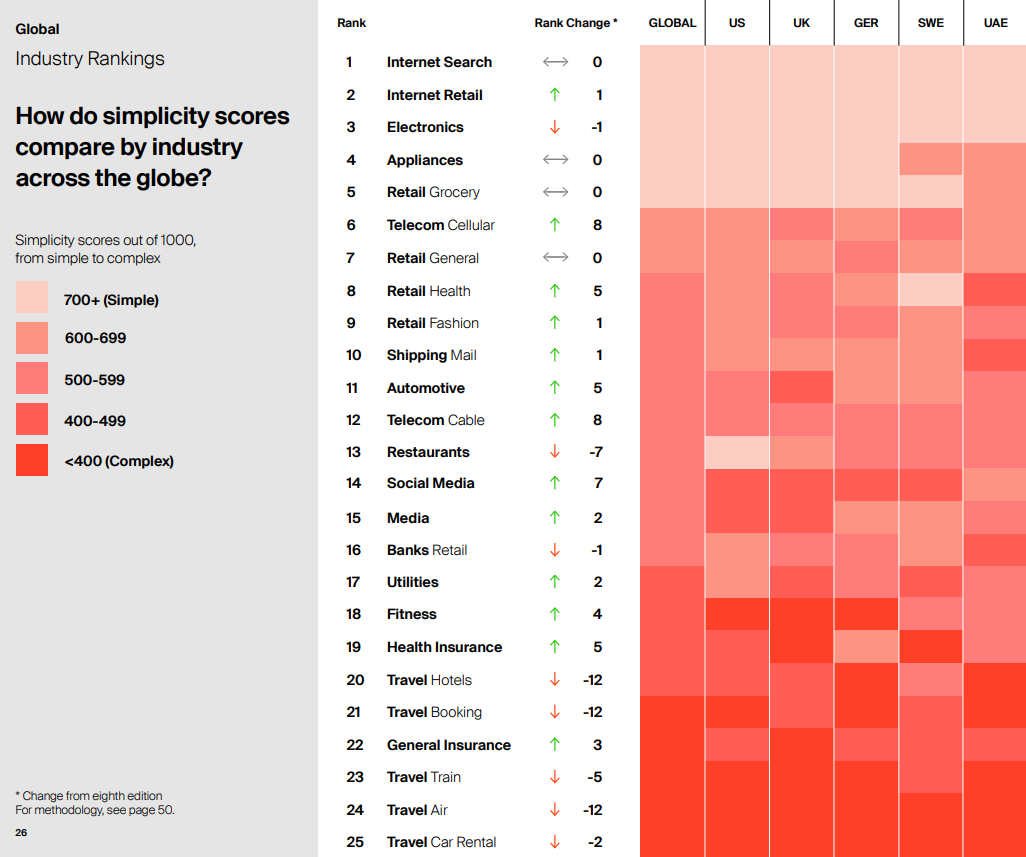
Understanding Insurance: Exploring Its Complexities
TABLE OF CONTENTS
Insurance is complicated. In fact, it’s the most confusing and complicated thing that many people ever spend their money on (see chart below from Siegel+Gales Simplicity Index). In fairness to insurers, simplicity is definitely a harder goal to achieve than in other industries, as the product they offer is inherently more complex. A lot of the reason that internet search is at the top is that it's naturally straightforward. You type in something you want to search for, click, and there the product (the search results) is. You don’t even need to pay for it; not directly at least.
KEY TAKEAWAYS
- 1
Insurance is a complex product due to the wide range of situations and conditions it covers, as well as the structure of policies and contracts.
- 2
The complexity of insurance is necessary in order to clearly define the limits and exclusions of coverage, as well as the responsibilities of both the insurer and insured.
- 3
The language used in insurance policies is often confusing and legally dense in order to protect the insurer from potential legal challenges and loopholes.
Reasons Why Insurance is Complicated
1. What the Product Provides
Even in an industry with a more complicated product like automobiles, simplicity is easier to achieve. Sure, the engineering that goes into a car, as with the code behind search results is fiendishly complex. But, the product itself is relatively comprehensible. It’s a machine that moves you places. Yes, there are more factors to consider (horsepower, safety ratings, miles per gallon, falcon wing doors, reliability, price, etc.). However, they are concepts that are easy to:
Conceptualize
Prioritize
Compare.
With insurance factors, it is much more difficult to do those first two things (and if you can’t do the first two, being able to do the third is useless).
In contrast to the inherent complexity of insurance, the reason for it is simple. Ford wants to sell you a product that moves you places. State Farm sells a product where you're paid to help undo a limited set of the cacophonous multitude of bad things that can happen.
This "limited" set is the real kicker. Insurance would be much simpler if they just covered you for every possible bad thing that could befall you, but they don’t (at least not with a typical standard policy) — in part, because the cost of paying for protection against that much risk would be beyond what most are willing/able to pay.
2. The Product is a Contract
In order to wrangle this complexity, insurers write policies (i.e. legal contracts) that define the range of situations and conditions they will cover. The major components consist of
Who the policy covers
Often negotiable depending on who the applicant wants to be insured.
How terms are defined
Lays out specifically what an insurer means by the use of certain words and phrases.
Limits of Coverage
Defines the maximum an insurer will pay, what situations they will cover, and how much the applicant must pay in deductibles or co-pays.
e.g. an insurer may pay out a maximum of $200,000 for damages to a home, but only after the insured pays their $2,500 deductible.
Exclusions
Details what situations or conditions the insurer will not cover.
e.g. an insurer might not cover perils associated with having a swimming pool unless surrounded by a fence.
Responsibilities of the insurer and insured
Provides conditions and rules for what the insured and insurer must do in certain circumstances.
e.g. in the event of a tree damaging a roof, the insurer may require the insured to take steps to prevent further damage.
3. The Contract is Confusing
The structure of these documents is easy enough to understand. It's the content therein that many find confusing, because of all the possibilities and situations it covers. It is possible to craft them with more understandable language, but that is counter-balanced by the need to maintain a policy's ability to withstand legal scrutiny.
In other words, if they were too simple, the policies could have loopholes that harm the insurer. Since they are "contracts of adhesion" where the insurer lays out the terms and the insured can only accept or reject it, gray areas tend to go in favor of the insured.
Yes, that can be read as "Oh, so the insurers have the complexity to avoid paying out on my rightful claim." While there may be some truth to that, it's also true that insurers sometimes live and die based on how their fine print is interpreted in court. If they have to pay a claim for something in their policy they didn't intend to (and thus didn't price that risk into the premium) they can find themselves in deep financial trouble.
4. Difficulty in Choosing Coverages
Case Study: Bodily Injury Liability Coverage
Another example of the difficulty with insurance is trying to figure out how much coverage you actually need. For instance, with auto insurance, bodily injury liability, one of the prime coverages, often has coverages starting at a minimum of around $25,000/$50,000 per person/accident, with additional coverage available to the millions.
For comparison, the average amount insurers paid out for these types of claims in 2015 was only $15,506 (though it’s unclear what the variance on that is, and the full report costs a cool $5,000 to maybe find out). Also, because many individuals are underinsured, the average is unnaturally skewed to a lower value than the true average of bodily injury damages.
Comparison based on net worth
So, does that mean though that you only need $25/50 of BI coverage or less? Well in part due to the increasing income gap, the answer could be “maybe.” If you are 1 of 4 Americans that have a negative net worth, extra coverage may be unnecessary since creditors can’t seize assets you don’t have, though your wages could potentially be garnished — unless you live in PA, SC, NC, or TX where it can be harder or impossible to do. See how insurance gets complicated fast? That is just one rabbit hole in a maze of them.
What if you are one of the other four Americans that is one step higher on the wealth totem pole? This group has an average of $31,000 to $36,000 in wealth. The lower end of liability coverage at $25/50 is now almost enough to cover the value of all your assets. But, if the damages exceed the coverage limits, your assets are on the hook for the rest. Though, coming back to the average of $15,506 for a bodily injury claim, how likely is that? The problem is that that average is skewed low because many Americans are underinsured. Consequently, higher value losses (that go beyond the limits covered) do not get accounted for in that number. But it is hard to tell by how much. Insurers spend good time and money modeling this sort of thing, and they have no incentive to share what helps make their secret sauce.
Suggested Coverage Level
The advice given by the NAIC is to “purchase the most coverage you can reasonably afford to protect your financial security,” which is simultaneously great and somewhat useless advice. Yes, that is probably a good amount of coverage to have. But, there’s no clear way to calculate exactly what that is. The general approximation provided is to have enough to cover your assets, or for a middle-income family to have $100,000/$300,000. What it really comes down to is how much appetite you have for risk and how much can you lose before it ruins your day, week, year, or life. Unfortunately, it’s hard to make a decision about that without any idea of the likelihood of those risks.
On the plus side, the price increase for higher bodily injury limits is generally quite low. From $25/50 to $50/100 or even $100/300 may cost as little as $1 to $5 dollars more per month. The same goes for property damage liability, where $50000 to $100000 could cost less than $0.50 extra per month. In any case, it’s worth seeing what the difference would cost for yourself.
Verdict
There is no one-size-fits-all solution. The correct amount of coverage depends primarily on your assets and tolerance for risk.
That said, going from low liability coverage to moderate or even great coverage generally costs so little extra that it is probably worth spending the extra few dollars for protection against those low-probability catastrophes that can arise. Let's say you’re considering $25/50 at a cost of around $20 per month. It’s probably worth paying $21 or $23 per month instead of $50/100 or $100/300. If you have assets in the hundreds of thousands or millions of dollars, going up to a coverage of $500/1000 or more will still likely only cost you an extra $4 or $5 per month, which should be a no-brainer at that point.
Conclusion
Hopefully, this provides an idea of why insurance is complicated, more so than other things people buy, and some insight into how to tackle that problem. Above all, remember to compare prices at different coverage levels for insurers you’re looking at, and between different insurers themselves, while taking into consideration the quality of those companies in terms of claims service.
A good place to get started doing that is over here. If you're looking to buy homeowners insurance, taking a look at our guide may also be of help. If you're wondering more about the complexity of health insurance, some answers can be found over here.
TABLE OF CONTENTS


Trying to find the best insurance?
We'll help you find the policy that offers the best value for your situation.
Further Reading

Navigating the Digital Insurance Landscape Considerations
A look at the immense value and high customer lifetime potential within the insurance sector.
Read article

When is Term Life Insurance Worth it?
Decide if term life's advantages are worth it: compare whole vs term life insurance, assess top term providers, and delve into in-depth reviews.
Read article

Insurance Binder: Bridging Between Coverage and Confirmation
From car loans to rental properties, insurance binders are required in a variety of situations. Discover the ins and outs of these essential documents.
Read article

Haven Life Review: Providing Prudent and Protective Policies
Uncover the benefits and drawbacks of Haven Life's term insurance policies, along with eligibility details, pricing, and customer feedback..
Read article
Start Comparing Quotes
Search from our learning center to learn everything from how to easily switch your car insurance to the ins and outs of home insurance.
Fill out just one form and get multiple quotes!



